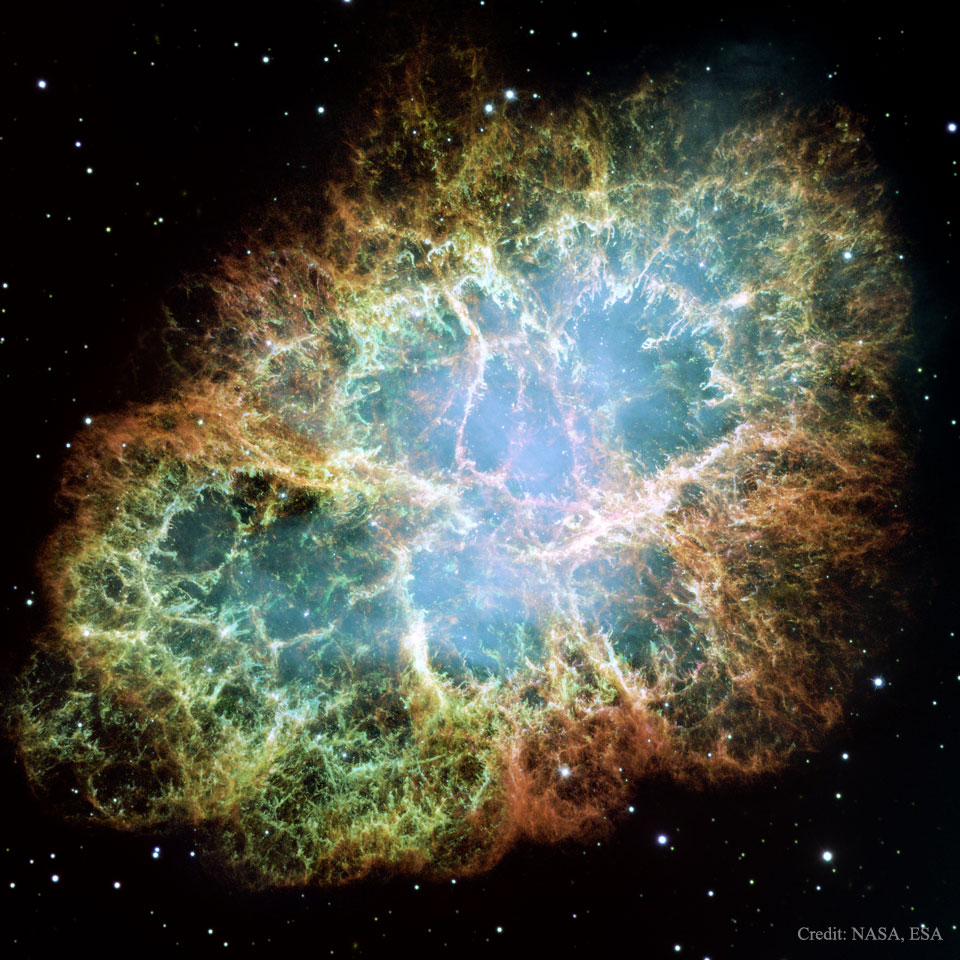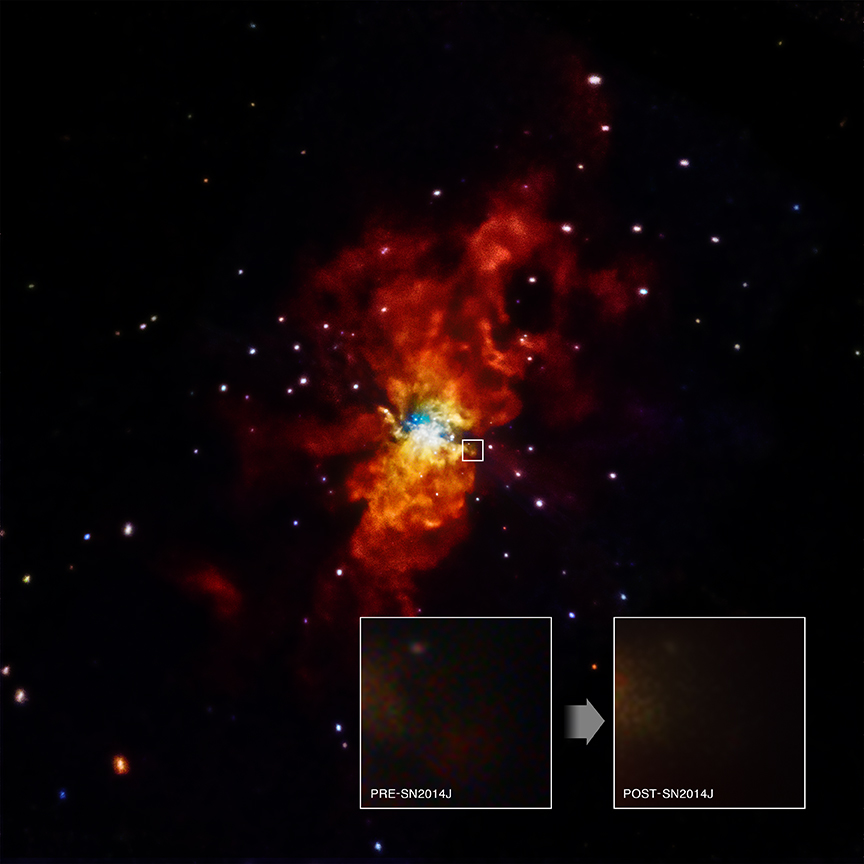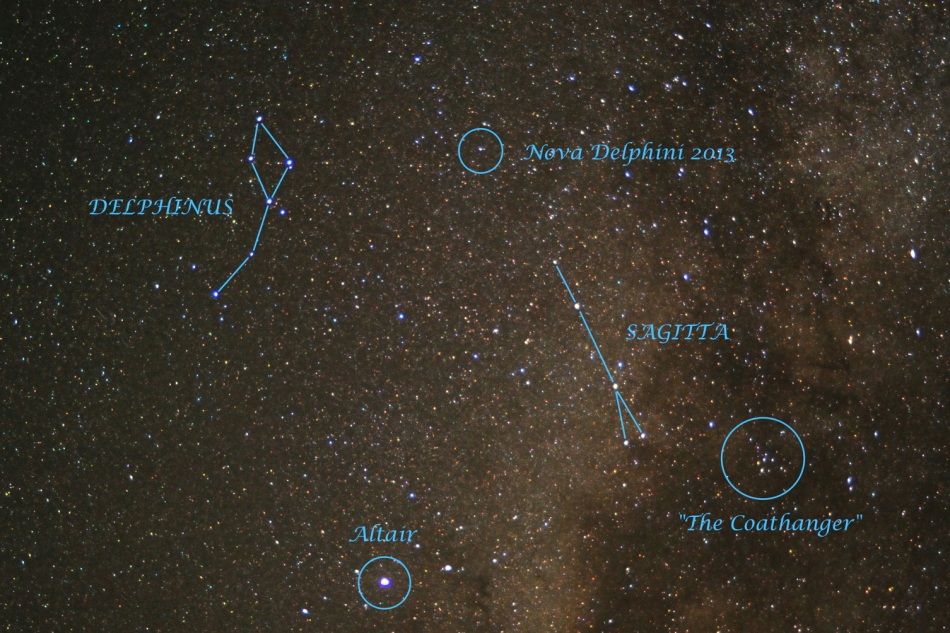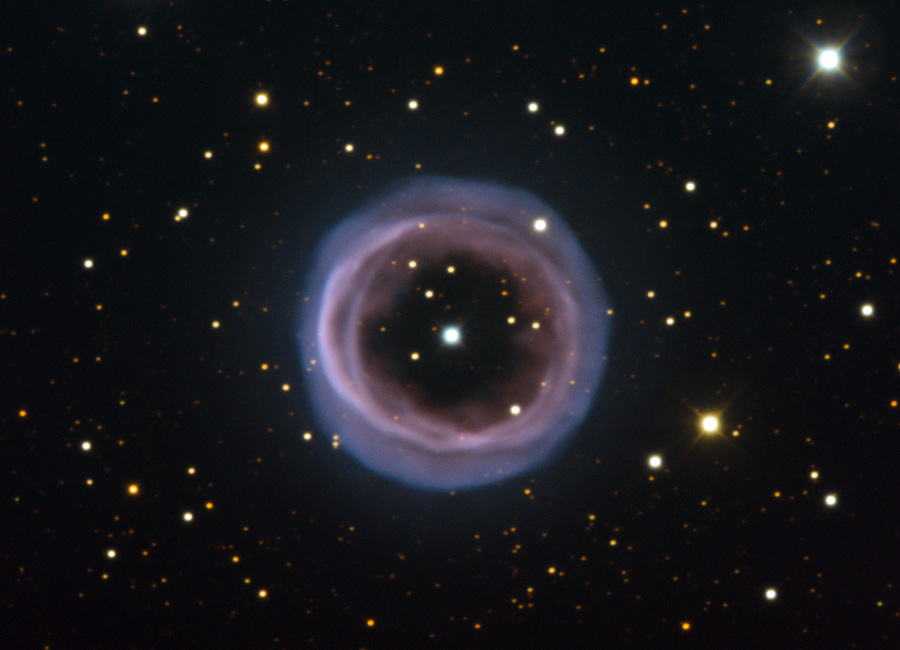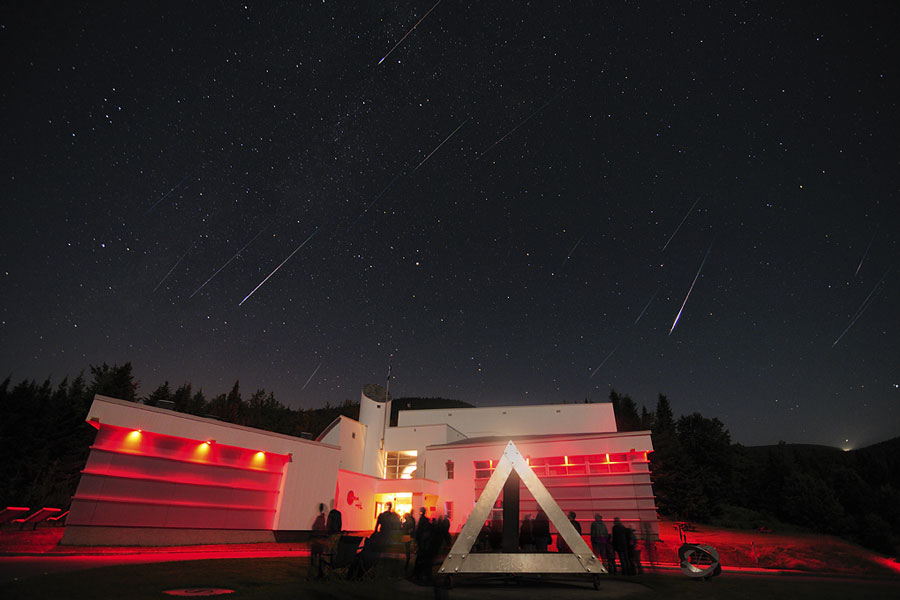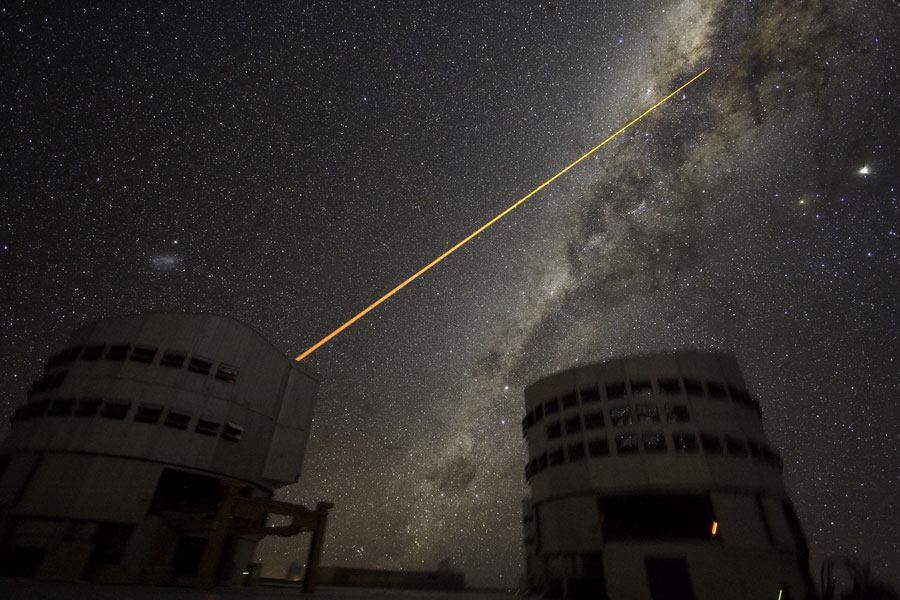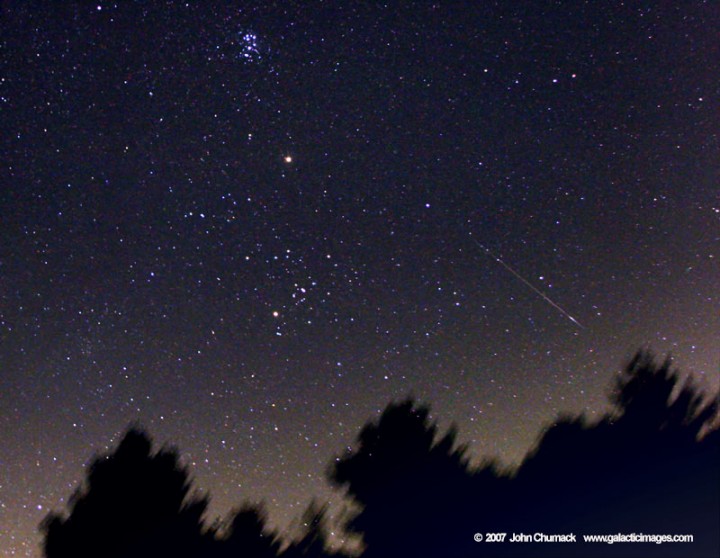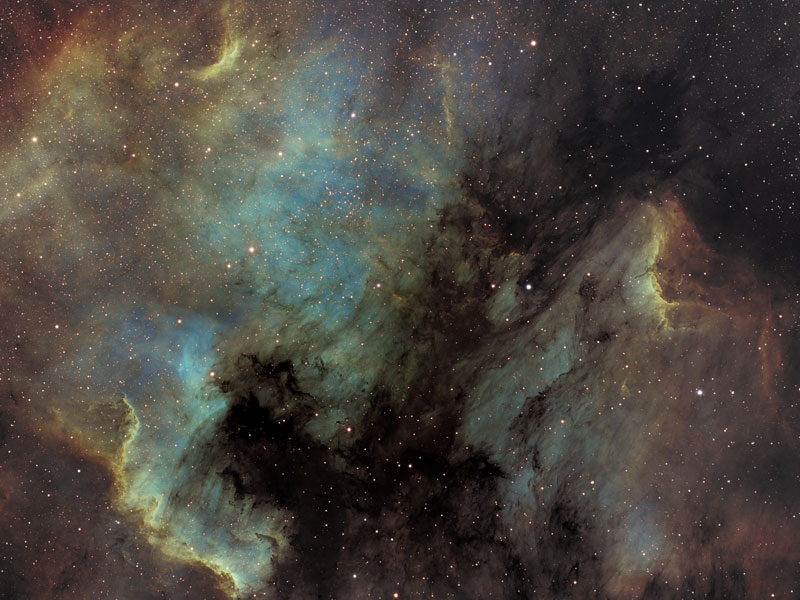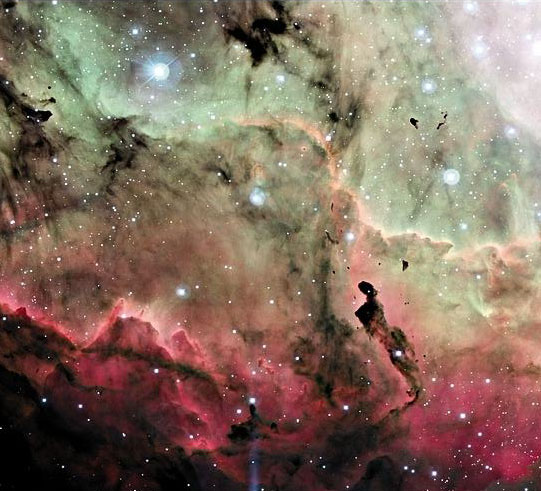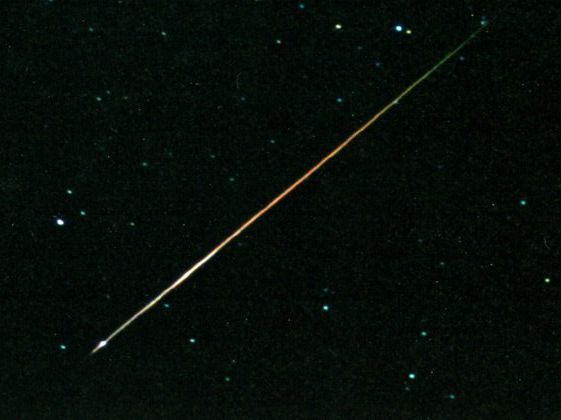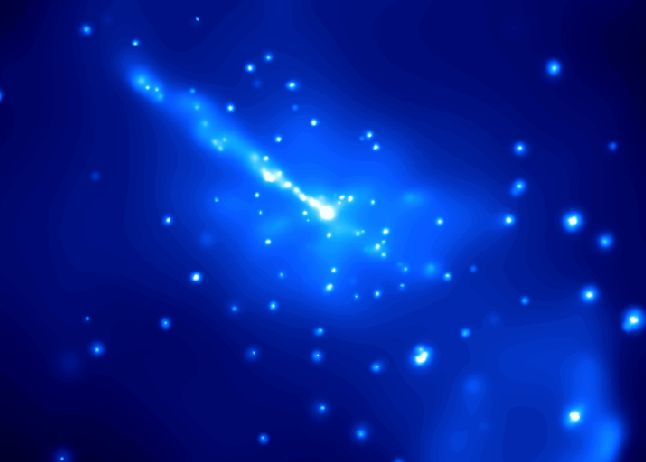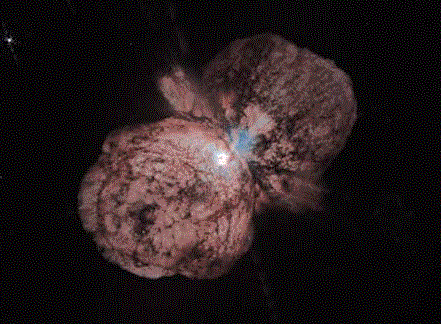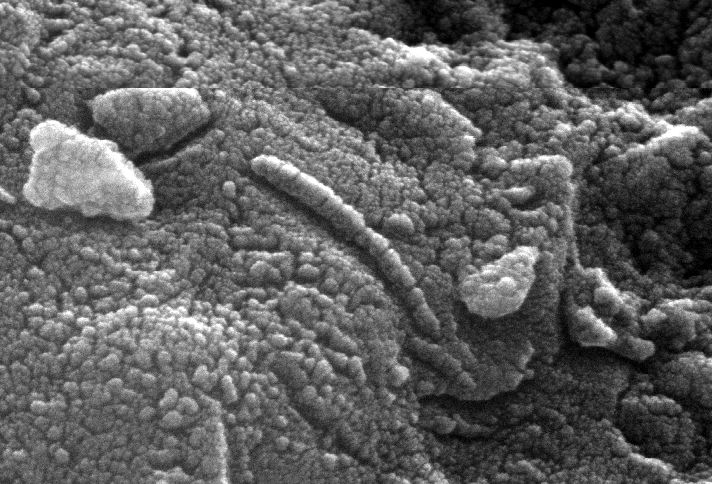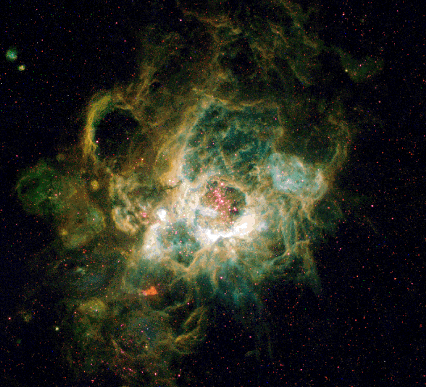| << Previous | Index | Next >> |
2015 This is the mess that is left when a star explodes. The Crab Nebula, the result of a supernova seen in 1054 AD, is filled with mysterious filaments. The filaments are not only tremendously complex, but appear to have less mass than expelled in the original supernova and a higher speed than expected from a free explosion. The featured image, taken by the Hubble Space Telescope, is presented in three colors chosen for scientific interest. The Crab Nebula spans about 10 light-years. In the nebula's very center lies a pulsar: a neutron star as massive as the Sun but with only the size of a small town. The Crab Pulsar rotates about 30 times each second.
2014 Last January, telescopes in observatories around planet Earth were eagerly used to watch the rise of SN 2014J, a bright supernova in nearby galaxy M82. Still, the most important observations may have been from orbit where the Chandra X-ray Observatory saw nothing. Identified as a Type Ia supernova, the explosion of SN2014J was thought to be triggered by the buildup of mass on a white dwarf star steadily accreting material from a companion star. That model predicts X-rays would be generated when the supernova blastwave struck the material left surrounding the white dwarf. But no X-rays were seen from the supernova. The mostly blank close-ups centered on the supernova's position are shown in the before and after inset panels of Chandra's false color X-ray image of the M82 galaxy. The stunning lack of X-rays from SN 2014J will require astronomers to explore other models to explain what triggers these cosmic explosions.
2013 Using a small telescope to scan the skies on August 14, Japanese amateur astronomer Koichi Itagaki discovered a "new" star within the boundaries of the constellation Delphinus. Indicated in this skyview captured on August 15 from Stagecoach, Colorado, it is now appropriately designated Nova Delphini 2013. Sagitta, the Arrow, points the way to the newcomer's location high in the evening sky, not far from bright star Altair and the asterism known to northern hemisphere skygazers as the Summer Triangle. The nova is reported to be easy to spot with binoculars, near the limit of naked-eye visibility under dark skies. In fact, previous deep sky charts do show a much fainter known star (about 17th magnitude) at the position of Nova Delphini, indicating this star's apparent brightness suddenly increased over 25,000 times. How does a star undergo such a cataclysmic change? The spectrum of Nova Delphini indicates it is a classical nova, an interacting binary star system in which one star is a dense, hot white dwarf. Material from a cool, giant companion star falls onto the surface of the white dwarf, building up until it triggers a thermonuclear event. The drastic increase in brightness and an expanding shell of debris is the result - but the stars are not destroyed! Classical novae are believed to recur when the flow of material onto the white dwarf resumes and produces another outburst.
2012 NGC 6888, also known as the Crescent Nebula, is a cosmic bubble about 25 light-years across, blown by winds from its central, bright, massive star. This colorful portrait of the nebula uses narrow band image data combined in the Hubble palatte. It shows emission from sulfur, hydrogen, and oxygen atoms in the wind-blown nebula in red, green and blue hues. NGC 6888's central star is classified as a Wolf-Rayet star (WR 136). The star is shedding its outer envelope in a strong stellar wind, ejecting the equivalent of the Sun's mass every 10,000 years. The nebula's complex structures are likely the result of this strong wind interacting with material ejected in an earlier phase. Burning fuel at a prodigious rate and near the end of its stellar life this star should ultimately go out with a bang in a spectacular supernova explosion. Found in the nebula rich constellation Cygnus, NGC 6888 is about 5,000 light-years away.
2011 What happens when a star runs out of nuclear fuel? For stars about the mass of our Sun, the center condenses into a white dwarf while the outer atmospheric layers are expelled into space and appear as a planetary nebula. This particular planetary nebula, pictured above and designated Shapley 1 after the famous astronomer Harlow Shapley, has a very apparent annular ring like structure. Although some of these nebulas appear like planets on the sky (hence their name), they actually surround stars far outside our Solar System.
2010 Meteors streaked through the sky above many of Earth's cities last week, but nobody was hurt, and no damage has been reported. The assault from space appeared to originate from someplace in the constellation of Perseus, and included millions of small projectiles hurtling toward Earth at over 200,000 kilometers per hour. Pictured above, people gathered at ASTROLab du Mont-Megantic in southern Quebec, Canada gazed helplessly toward the sky during a similar event last year as they themselves were unable to stop the meteor onslaughts. Fortunately, Earth's defense, consisting of a planet-wide blanket of air over 100-kilometers thick, obliterated the attacking projectiles by using friction generated by their own speed to heat them into disintegration. The large triangle in the foreground, although impressive in appearance, was not part of the Earth's meteor defense system. The space attack was expected as part of the annual Perseids meteor shower as the Earth passed through sand-sized debris left over from the sun-orbiting Comet Swift-Tuttle.
2009 Why are these people shooting a powerful laser into the center of our Galaxy? Fortunately, this is not meant to be the first step in a Galactic war. Rather, astronomers at the Very Large Telescope (VLT) site in Chile are trying to measure the distortions of Earth's ever changing atmosphere. Constant imaging of high-altitude atoms excited by the laser -- which appear like an artificial star -- allow astronomers to instantly measure atmospheric blurring. This information is fed back to a VLT telescope mirror which is then slightly deformed to minimize this blurring. In this case, a VLT was observing our Galaxy's center, and so Earth's atmospheric blurring in that direction was needed. As for inter-galaxy warfare, when viewed from our Galaxy's center, no casualties are expected. In fact, the light from this powerful laser would combine with light from our Sun to together appear only as bright as a faint and distant star.
2008 Colorful and bright, the city lights of Vancouver, Canada are reflected in the water in this portrait of the world at night. Recorded on August 12 during the Perseid Meteor Shower, the wide-angle view takes in a large swath along the photographer's eastern horizon. The picture is a composite of many consecutive 2 second exposures that, when added together, cover a total time of an hour and 33 minutes. During that time, stars trailed through the night sky above Vancouver, their steady motion along concentric arcs a reflection of planet Earth's rotation. The dotted trails of aircraft also cut across the scene. Of course, two of the frames captured the brief, brilliant flash of a Perseid fireball as it tracked across the top of the field of view. The large gap in the single meteor trail corresponds to the time gap between the consecutive frames.
2007 Last weekend, dark, moonless night skies brought many sightings of Perseid meteors to skygazers all over planet Earth. Early Sunday morning astronomer John Chumack's camera captured this Perseid meteor streak with a flare near the end of its track over Yellow Springs, Ohio. The single, four minute long exposure looks toward the constellation of Taurus and the eastern horizon. The meteor streak points back to the annual meteor shower's radiant in Perseus off the upper left corner of the picture. Of course, the view includes the well-known Pleiades Star cluster (near top center) with a bright yellowish planet Mars below it. Also seen with a yellowish tint but not quite as bright as Mars, the giant star Aldebaran anchors the V-shaped Hyades star cluster left of center, above the trees.
2006 Here are some familiar shapes in unfamiliar locations. This emission nebula on the left is famous partly because it resembles Earth's continent of North America. To the right of the North America Nebula, cataloged as NGC 7000, is a less luminous nebula that resembles a pelican dubbed the Pelican Nebula. The two emission nebula measure about 50 light-years across, are located about 1500 light-years away, and are separated by a dark absorption cloud. This spectacular image captures, in false color, the nebulas, bright ionization fronts, and fine details of the dark dust. The nebulae can be seen with binoculars from a dark location. Look for a small nebular patch north-east of bright star Deneb in the constellation of Cygnus. It is still unknown which star or stars ionize the red-glowing hydrogen gas.
2005 The International Space Station (ISS) is the largest human-made object ever to orbit the Earth. Late last month and earlier this month, the station was visited and resupplied by space shuttle Discovery. The ISS is currently operated by the Expedition 11 crew, consisting a Russian and an American astronaut. After departing the ISS, the crew of Discovery captured this spectacular vista of the orbiting space city. Visible components include modules, trusses, and expansive solar arrays that gather sunlight that is turned into needed electricity.
2004 Stars are battling gas and dust in the Lagoon Nebula but the photographers are winning. Also known as M8, this photogenic nebula is visible even without binoculars towards the constellation of Sagittarius. The energetic processes of star formation create not only the colors but the chaos. The red-glowing gas results from high-energy starlight striking interstellar hydrogen gas. The dark dust filaments that lace M8 were created in the atmospheres of cool giant stars and in the debris from supernovae explosions. This spectacular portion of the Lagoon Nebula taken by the CFHT was created from light emitted by hydrogen (shown in red) and light emitted by oxygen (shown in green). The light from M8 we see today left about 5000 years ago. Light takes about 50 years to cross this section of M8.
2003 Rich star fields and glowing hydrogen gas silhouette dense, opaque clouds of interstellar gas and dust in this Hubble Space Telescope close-up of IC 2944, a bright star forming region in Centaurus, 5,900 light-years away. The largest of these dark globules, first spotted by South African astronomer A. D. Thackeray in 1950, is likely two separate but overlapping clouds, each more than one light-year wide. Combined the clouds contain material equivalent to about 15 times the mass of the Sun, but will they actually collapse to form massive stars? Along with other data, the sharp Hubble images indicate that Thackeray's globules are fractured and churning as a result of intense ultraviolet radiation from young, hot stars already energizing and heating the bright emission nebula. These and similar dark globules known to be associated with other star forming regions may ultimately be dissipated by their hostile environment -- like cosmic lumps of butter in a hot frying pan.
2002 While meteors do show colors, the colors aren't always seen with the unaided eye. Still, high speed color film recorded this rainbow-like trail as a meteor streaked through the early morning sky on August 13 above Sedona, Arizona, USA. Part of the annual Perseid meteor shower, this bit of dust from the tail of Comet Swift-Tuttle entered Earth's atmosphere at over 200,000 kilometers per hour. The trail it left glowed briefly as friction with the atmosphere vaporized the dust grain and ionized atoms along its path. The initial green color is thought to be the glow from oxygen in the atmosphere at altitudes above 100 kilometers or so, while sodium atoms and other constituents of the cometary dust grain itself contribute to the orange hues.
2001 Its core hidden from optical view by a thick lane of dust, the giant elliptical galaxy Centaurus A was among the first objects observed by the orbiting Chandra X-ray Observatory. Astronomers were not disappointed, as Centaurus A's appearance in x-rays makes its classification as an active galaxy easy to appreciate. Perhaps the most striking feature of this Chandra false-color x-ray view is the jet, 30,000 light-years long. Blasting toward the upper left corner of the picture, the jet seems to arise from the galaxy's bright central x-ray source -- suspected of harboring a black hole with a million or so times the mass of the Sun. Centaurus A is also seen to be teeming with other individual x-ray sources and a pervasive, diffuse x-ray glow. Most of these individual sources are likely to be neutron stars or solar mass black holes accreting material from their less exotic binary companion stars. The diffuse high-energy glow represents gas throughout the galaxy heated to temperatures of millions of degrees C. At 11 million light-years distant in the constellation Centaurus, Centaurus A (NGC 5128) is the closest active galaxy.
2000 Can unusual giant galaxy NGC 1316 help calibrate the universe? Quite possibly -- if it turns out this atypical galaxy is composed of typical stars. NGC 1316, pictured above, is most obviously strange because it has a size and shape common for an elliptical galaxy but dust lanes and a disk more commonly found in a spiral galaxy. These attributes could be caused by interactions with another galaxy over the past billion years. Most recently, NGC 1316 has been monitored to find novae, explosions emanating from white dwarf stars that should have a standard brightness. Again, NGC 1316 was found atypical in that the nova rate was unexpectedly high. If, however, the stars and white dwarfs that compose NGC 1316 are typical, then the novae observed should be just as bright as novae in other galaxies so that astronomers can use them to compute an accurate distance. This distance can then be used to calibrate other distance indicators and result in a more accurate scale for distances throughout the universe.
1999 Mars may be a cold, dry planet but its weather is dynamic. On June 30, wide angle cameras on board the Mars Global Surveyor (MGS) spacecraft watched the development of this large scale storm system above Mars' north polar area. These frames were recorded on successive mapping orbits at intervals of about 2 hours, with the white north polar cap near the center of each. High winds seem to mix the brownish dust clouds and white water-ice clouds as the curling storm front churns over the extreme northern martain landscape. The MGS cameras have watched similar storms in this region during the months of July and August revealing surprisingly complex weather. Mars Climate Orbiter will join the MGS spacecraft in martian orbit in late September, and in December Mars Polar Lander is scheduled to touch down near the Red Planet's south pole.
1998 Eta Carinae may be about to explode. But no one knows when - it may be next year, it may be one million years from now. Eta Carinae's mass - about 100 times greater than our Sun - makes it an excellent candidate for a full blown supernova. Historical records do show that about 150 years ago Eta Carinae underwent an unusual outburst that made it one of the brightest stars in the southern sky. Eta Carinae, in the Keyhole Nebula, is the only star currently thought to emit natural LASER light. This image, taken in 1996, resulted from sophisticated image-processing procedures designed to bring out new details in the unusual nebula that surrounds this rogue star. Now clearly visible are two distinct lobes, a hot central region, and strange radial streaks. The lobes are filled with lanes of gas and dust which absorb the blue and ultraviolet light emitted near the center. The streaks remain unexplained. Will these clues tell us how the nebula was formed? Will they better indicate when Eta Carinae will explode?
1997 Alien! Alien? Is this what an ancient Martian looked like? The tube-like form on the above highly magnified image is now believed by many to be a fossil of a simple Martian organism that lived over 3.6 billion years ago. If this extraordinary claim is true, this alien could hardly have been less intimidating as its fossil measures less than 1/100th the width of a human hair. A reconstruction of events indicates that the meteorite that housed this potential fossil was catapulted from Mars during a huge impact 16 million years ago and fell to Earth's Antarctica only 13,000 years ago. Evidence supporting this claim of early Martian life includes organic molecules and mineral features characteristic of biological activity found in the meteorite. NASA's current missions to Mars are Mars Global Surveyor and Mars Pathfinder. Though not designed to look for martian fossils, these missions may reveal information about conditions on early Mars which might have been more favorable for life.
1996 The nebula cataloged as NGC 604 is a giant star forming region, 1500 light years across, in the nearby spiral galaxy, M33. Seen here in a snapshot by the Hubble Space Telescope, over 200 newly formed, hot, massive, stars are scattered within a cavern-like, gaseous, interstellar cloud. The stars irradiate the gas with energetic ultraviolet light stripping electrons from atoms and exciting them - producing a characteristic nebular glow. The details of the nebula's structure hold clues to the mysteries of star formation and its effect on the evolution of galaxies.
1995 This picture was snapped by the Voyager 2 spacecraft in 1986 - the only spacecraft ever to visit Uranus. Uranus is the third largest planet after Jupiter and Saturn. Uranus has many moons and a ring system. Uranus is composed mostly of liquid water, methane and ammonia, surrounded by a thick gas atmosphere of mostly hydrogen and helium. Uranus is peculiar in that its rotation axis is greatly tilted and sometimes points near the sun. It remains an astronomical mystery why Uranus' axis is so tilted. Uranus and Neptune are very similar.
| << Previous | Index | Next >> |
